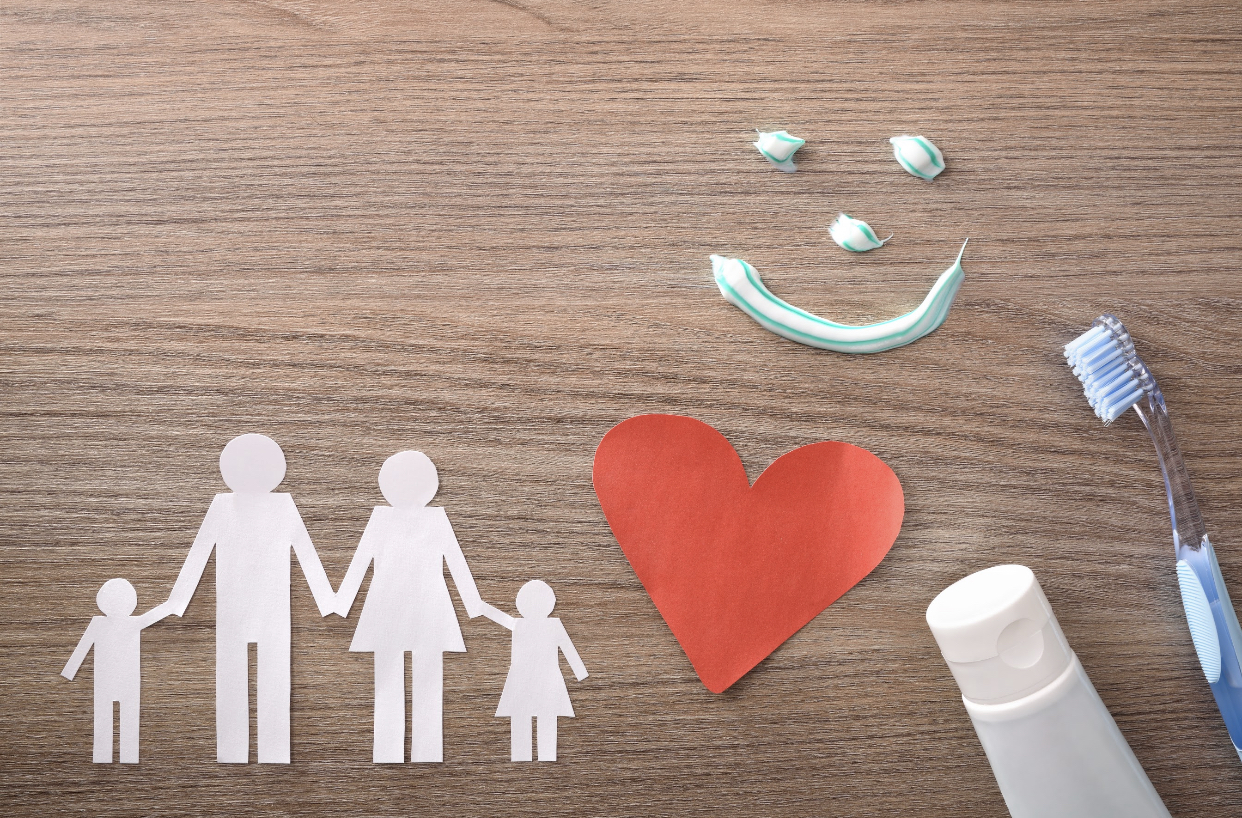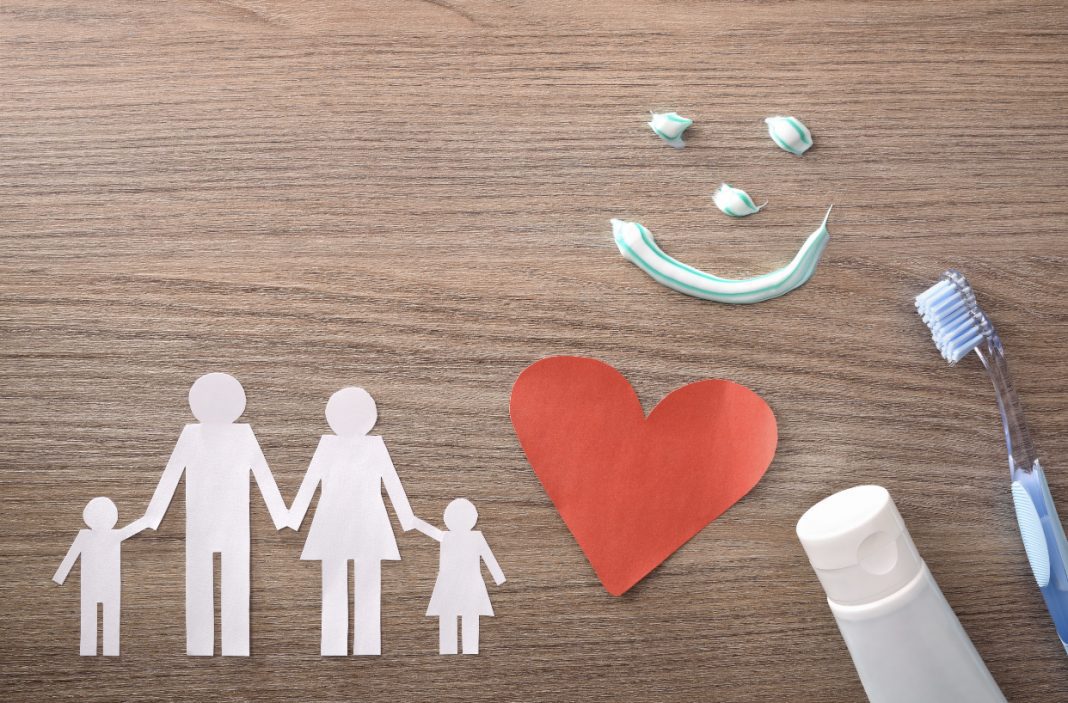
A smile is always endearing no matter the age of the person or the number of their teeth. A baby’s toothless smile can melt hearts, a beaming youngster makes parents proud, while a bright look can make any adult attractive.
Rows of pearly whites aren’t achieved over night as it actually goes back to what you were taught when you first got your two front teeth. The home is the best learning venue for all things good—including caring for your teeth and gums.
Unfortunately, caring for your family’s oral health can be challenging, especially when you have children of various ages with different sets of choppers. You may even have older adults in the home that may have diminishing motor skills, or others who have disabilities that make brushing rather challenging. Or you may be pregnant and require a special type of dental care as well. In these situations, you’ll need a guide on how you can make oral hygiene not only a priority but a fun activity for the whole family.
Caring For Your Family’s Oral Health
Moms and dads are often in charge of all family affairs including everyone’s oral health. They work together to ensure cavities and tooth decay don’t harm the little ones and habits don’t cause mouth diseases in older children or adults living with the family.
As parents, you’ll need to know how to handle everything related to teeth or its loss, and also model good oral hygiene. The tips below can help you carry out this task to make sure everyone retains their bright smile whether they’re six or sixty.
1. Oral Health Starts With You
Parents should model good oral health habits to their children. While you probably know the drill, it helps to remind your partner and urge them to care for their teeth and gums. Poor oral health is tied to chronic diseases such as high blood pressure, diabetes, and obesity. You would want to remain healthy to see your kids grow, so it’s best to stick to your oral care routine.
Pregnant moms need to include oral health as part of their pre-natal care since they’re at a greater risk for gum disease and cavities. Caring for your teeth is closely tied to your baby’s future oral health so it’s best to see dentists several times during your pregnancy. If you’re in Idaho, you can set an appointment with Familydentalhealth.com to have your teeth checked.
2. Start Them Young
Moms and dads don’t need to wait until their little one has grown their teeth before they start with oral care. Start wiping their gums with a soft wet cloth before their first baby tooth gets out. This is to keep away bacteria. You can also use a finger brush so they will get used to having their mouth cleaned.
Once teeth begin to show, you’ll need to brush them twice a day. You can transition to a kiddie toothbrush with larger handles so you won’t fall prey to their chomping tendencies. Use fluoride toothpaste the size of a grain of rice for children below three years old and teach them to face downward so the toothpaste can drop to a cup or into the sink. Have them practice spitting out the toothpaste as they grow older.
You can also introduce them to the dentist while they’re young. Look for a pediatric dentist that your child feels comfortable with and make sure to accompany them during dental appointments. Get involved with what needs to be done, whether it’s a filling or getting an extraction. Don’t be afraid to voice out your fears and concerns as professionals are more than willing to help you out.
3. Make It Fun
It can be frustrating to play catch just to get kids to brush before bedtime. You may even get tired of reminding older children over and over again. Oral care doesn’t have to be boring. You can make this a fun activity for the entire family. Go ahead and brush together so you can all achieve pearly whites!
For toddlers and preschoolers, you can have them choose toothbrushes in their favorite color or with their favorite cartoon character on the handle. Have them decide which cup to use and even the flavor of their toothpaste. Just make sure to choose fluoride toothpaste to help protect baby or even permanent teeth.
You can even entice them with electric toothbrushes that light up or play music to make brushing enjoyable. Alternately, you can have them listen to a song or count down as they brush for two full minutes. Have a dental calendar family members can check when they finish their oral care routine for the day and reward the most diligent brusher every week or once a month.
4. Provide Adequate Nutrients
One needs to be mindful of the things one puts into their mouth as they can make or break the teeth. Eating sugary food and drinking soda or juice produces acids that weaken the enamel in our teeth.
It’s important everyone gets a load of fruits and veggies as they contain essential nutrients such as Vitamin C, D, K, calcium, and phosphorus. Add protein sources such as eggs, fish, tofu, fat-free milk, and soymilk. Offer yogurt, cheese and raw fruits for snacks rather than candies or cookies.
When it comes to drinks, infants younger than 12 months should have as much breastmilk or infant formula as they can take. For toddlers, it’s best to limit juices and other sugary beverages and never put them to bed with a bottle. Milk left on the gums can cause tooth decay and eventually lead to tooth loss.
5. Drink Water
Water can do wonders for our bodies and it works really well for oral health. Rinsing your mouth after every meal removes food particles that get stuck on the teeth and gums. It also washes away stains and bacteria that can cause bad breath. Drinking more water also prevents dry mouth and fluoridated drink lessens the chances of having tooth decay.
Make water more appealing for little ones by putting a slice of orange or lemon and adding mint leaves. You can also add blueberries or strawberries and animal or letter-shaped ice cubes. Put them in their favorite water bottles and use bendy or colored straws to make it spill-free.
Teenagers and adults need more convincing than kids. Do you want to know what works? Use the calorie appeal. Point out that water is essentially calorie and sugar-free and they’ll eagerly take that glass or a refill.
6. Brushing and Flossing
Oral hygiene isn’t complete without brushing and flossing. Brush your teeth with a soft-bristle toothbrush and use fluoride toothpaste. Use circular motions to scrub teeth and make sure you brush your tongue and the roof of your mouth as well. Spit out the excess toothpaste and don’t rinse immediately so fluoride can protect your teeth longer. Remember to replace your toothbrushes every three months.
When it comes to toothpaste sizes, keep in mind that a rice-grain size is enough for toddlers while a pea-size will do for kids older than three. Make sure you and your kids brush twice a day with one time before bedtime.
Aside from brushing, it’s also a good idea to floss to remove food in between teeth. Find time to floss and follow the two-minute rule as well. A flosser or gum pick works well. You can also chew gum if you can’t brush after a meal.
7. Tailor Oral Hygiene Routine
Oral care routines vary with age. Some family members may even need assistance. Children with disabilities and older adults may lack fine motor skills needed for brushing or flossing. As their caregiver, you can help them clean their teeth by strapping a hair band or Velcro to your child or older adult’s hand.
 You can also guide them with your hands as they brush. Electric or battery-operated toothbrushes can also make brushing more convenient as long as it’s used under supervision.
You can also guide them with your hands as they brush. Electric or battery-operated toothbrushes can also make brushing more convenient as long as it’s used under supervision.
Remind adults with dentures to take them off at night to avoid swollen gums. Brush them with a denture-cleaning product then soak in water or a denture-cleansing liquid. Gums may change over time so it’s best to see the dentist for adjustments or replacement dentures.
8. Quit Nasty Habits
Aside from food and oral care routines, you also need to refrain from various habits that could damage teeth. Find ways to keep children from nail-biting or using teeth as tools to cut or open food packets. Remind them not to grind ice with their teeth as it could lead to sensitive teeth and gums.
Teens and adults should also quit smoking since it stains teeth and increases the risk of gum disease and oral cancer.
Parents and caregivers also need to stop seemingly harmless habits such as sneezing without covering your mouth, blowing or tasting very hot food, and sharing utensils with children. Saliva can pass on Streptococcus Mutans from one person to another which can cause cavities. Even kissing your child on the lips can increase chances of tooth decay in the family.
9. Visit Your Dentist
Regular dental checkups ensure our teeth are strong and clean. They also take care of emergencies such as broken teeth and prevent serious oral health problems such as cavities and gum diseases. They can provide information on aligners vs braces and may even offer oral cancer screening for older adults. Dentists and their staff help us maintain our smiles so it’s best to develop a good relationship with them.
10. Explore Dental Insurance Or Other Alternatives
Dental services can be costly, especially if it cannot cover everyone in the family. If you’re working, you can take advantage of dental coverage from your employers. You can also choose to purchase a supplemental plan for seniors or additional Medicare dental premiums.
You can also choose to build a dental emergency fund to handle dental services for the entire brood. Or, you can sign up for a dental savings plan that connects you to a network of dental professionals across the country. Other budget-friendly alternatives include community health centers or websites that allow you to compare prices.
Conclusion
Caring for your family’s oral health begins even before they have teeth. Parents can serve as role models for proper oral care routines and can teach children how eating fruits and vegetables, drinking water, brushing, and flossing can keep teeth healthy and strong. While you may need to be more creative to make sure family members pay attention to their oral health, you’ll surely feel proud when they can smile at the world with confidence.

















